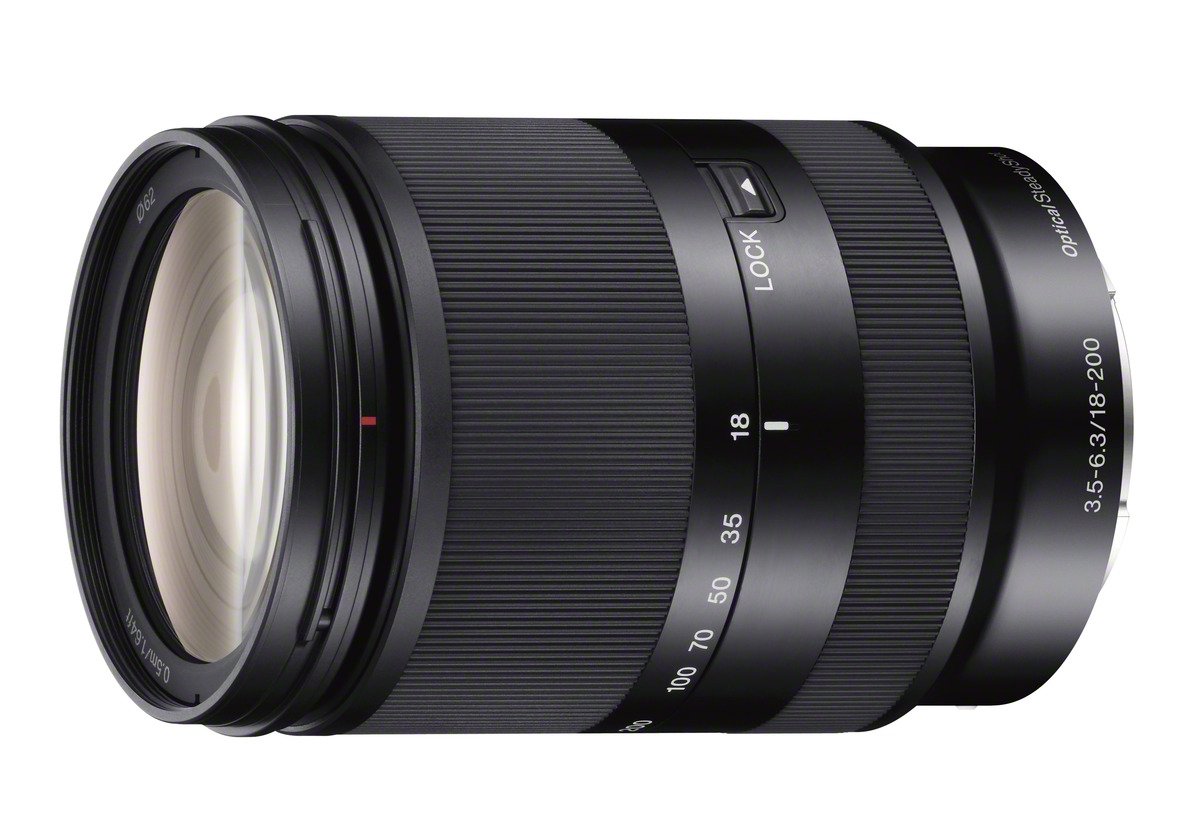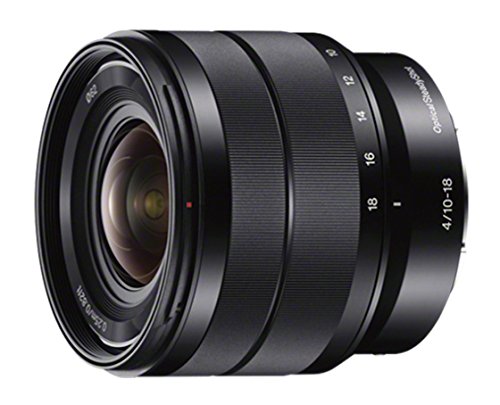The Sony A6300 is a 24.2 megapixel with a generally slim magnesium alloy body. It is fully equipped with WiFi and NFC connection. Its ISO sensitivity range is ISO 100-51200 and this functions on the synchronization of the APS-C sized Exmor CMOS sensor and the BIONZ X image processing engine. It contains a 4D FOCUS system of 425 phase detection AF points and shoots 4K video with full pixelation in the Super 35mm format. It can shoot images at an extraordinary 11fps-giving it a special relationship to the below telephoto lenses.
Travel & Casual Photography
Certain lenses of the Sony A6300 allow for ease of use and adaptability. This makes them great for shots like travel and interesting activities, where someone would rely more so on the uniqueness or scene of the situation to give the picture it’s worth.

Sony 18-105mm f/4 OSS
Rating
|
Pros |
CONS |
|---|---|
|
|
Specifications
This medium telephoto lens includes 16 glass elements in 12 groups. These contain 2 extra dispersion elements and 3 aspherical elements. It’s minimum focusing distance is particularly close at 0.45m and it has a maximum reproduction ratio of 1:9. It features Sony’s Handycam technology for an impeccably smooth zoom function-the speed of which can be altered and controlled for its many casual uses. It’s build as a generally light metal frame around plastic interior structures makes the lens less durable than it appeals. It’s size is a bit general for its type-weighing at 427g.
Review
The Sony 18-105mm f/4 OSS is a great fit onto the A6300. As a telephoto lens in the lower to medium range, this is a good gadget to test out the speed of the A6300 as it’s 11fps is in the highest range of Sony models. Between an introduction to the camera’s speed and a smooth zoom function this lens is amazing for exploring and traveling in addition to a wide range of quirky everyday uses.

Sony 18-200mm f/3.5-6.3 OSS
Rating
|
Pros |
CONS |
|---|---|
|
|
Specifications
The Sony 18-200mm f/3.5-6.3 OSS May be the most versatile lens on this list. Its optical design features 17 glass elements in 13 groups. These include 4 aspherical elements and 2 extra dispersion elements. It has a minimum focusing distance of 0.3m and a maximum magnification ratio of 0.35x.
Review
This lens does it all. It maintains optical quality throughout its wideangle and telephoto capabilities. In addition to everyday use, it is convenient for capturing sports, wildlife, landscapes and portraits. Most lenses this dynamic are pretty heavy but this one is compact and relatively lightweight. We recommend this as a top option for a beginner to test out and grow into. The fast continuous shooting of the A6300 make this an exciting match to explore with.
Sports & WildlifeSports & Wildlife
We typically separate the Sports and Wildlife categories for a more specific analysis. However, due to Sony’s limited telephoto option’s, we have chosen to combine them in this article for simplicity. Have a look at:

Sony 55-210mm f/4.5-6.3 OSS
Rating
|
Pros |
CONS |
|---|---|
|
|
Specifications
The Sony 55-210mm f/4.5-6.3 OSS fits greatly on the E mount lens of the Sony A6300 for great image stabilization (IS) and optical quality. The IS system claims up to 4 stops. The main qualities that make that make this a solid telephoto option are the internal focusing and fast overall autofocus. The lens construction. Is 13 glass elements in 9 groups, including 2 aspherical elements and 2 extra dispersion elements. It has a minimum focusing distance of 1m and a maximum magnification ratio of 0.23x.
Review
This is a good range telephoto lens at a tremendously low cost. It’s shortcomings are enhanced by the advanced qualities of A6300 such as its 11fps-making this one of the best deals on this list.
Small Objects and Minute Detail
Macro shots are those intended to convey minute detail. These include those for scientific and artistic purposes as well as close up shots of nature and insects. These lenses magnify smaller objects to real life size. Check out:

Sony FE 50mm f/2.8 Macro
Rating
|
Pros |
CONS |
|---|---|
|
|
Specifications
The Sony FE 50mm f/2.8 Macro is a classic and intuitive fit onto E class camera frames such as the Sony A6300. It has a super close minimum focusing distance of 0.16m and a standard macro maximum focusing ratio of 1. In addition to its compact size, it’s handling is simple with the controls of focus range limiter, focus mode switch and focus hold button all set together in a simple format. This lens is made of 8 glass elements in 7 groups, with one aspherical element and one extra low dispersion element.
Review
The truly amazing thing about this macro lens is its versatility. In addition to excelling at its macro functions, it can also be used for portrait or landscape photography. It handles well with compact size and easily accessible controls. The only drawback is its autofocus which makes a tad bit of noise. However, this shouldn’t be an issue for most engaging in macro photography.

Sigma 70mm f/2.8 DG Macro Art
Rating
|
Pros |
CONS |
|---|---|
|
|
Specifications
This lens is a quality macro option with great range and a bit of an edge to its functionality. Its lens is constructed from 13 glass elements in 10 groups. These contain one aspherical element, 2 super low dispersion elements and 2 fluoride low dispersion elements. These do a great shop at preventing chromatic aberration. Ghosting and flare is also countered with its relatively small filter diameter of 49mm. It also has a sleek design with basic internal focusing. The minimum focusing distance is 0.25m and the maximum magnification ratio is the standard 1 for macro lenses.
Review
The Sigma 70mm f/2.8 DG Macro Art represents phenomenal value, especially when measured against the Sony 50mm f/2.8. For greater range and comparative specs, the user pays a bit less. Sounds like a no brainer right? Well so much of photography is based in comfort and preference. So the brand’s corresponding fit as well as the great controls of the Sony could win some over-especially those more familiar with the Sony brand. It lacks an in-built image stabilization system and also has a somewhat fussy autofocus system. However, it’s firmware capability with AF updates via the Sigma Optimization Pro USB connection make the latter a minimal concern. Nonetheless, we highly recommend exploring this option-especially if shopping on a budget.
Portraits
The typically low light shots of portraits and special events are an absolute perfect fit with a few of the A6300 lenses. We only feature the consummate longer range options as we believe only those compatible with this quality of camera. Have a look at:

Sony 35mm f/1.8
Rating
|
Pros |
CONS |
|---|---|
|
|
Specifications
The Sony 35mm f/1.8 not only has the ideally high aperture but it other qualities speak for itself. It’s maximum magnification ratio is 0.15x and it has a minimum focusing distance of 0.3m. It’s lens it’s consists of 8 glass elements in 6 groups. It is supremely lightweight at only 155g.
Review
In addition to great portrait shots this lens is great for nighttime photography due to its low light performance. Coordinated with the great ISO levels of the Sony A6300, this pair is particularly ideal for up close shooting in pursuit of intimate and sensational effect. Yet most importantly, it is super sharp. This well rounded performance makes it a great value at its low price. If you’re serious about taking portraits, you will not be disappointed.

Sony 50mm f/1.8
Rating
|
Pros |
CONS |
|---|---|
|
|
Specifications
The Sony 50mm f/1.8 has straightforward specs of a versatile portrait lens of ideal range. It’s lens is constructed of 6 glass elements in 5 groups. It has a minimum focusing distance of 0.45m and a maximum magnification ratio of 0.14x. It boasts a Double Gauss optical design and an efficient DC autofocus motor.
Review
This lens is a great investment for the portrait photographer involved in a wide range of portrait types. Yet, one should really reflect as to whether they need additional range as they could save money with the similarly specified Sony 35mm f/1.8. It is also important to note the distinction between the Zeiss portrait lenses (50mm and 85mm) that we suggest with the Sony A7iii. Advanced fps and ISO performance on the A6300 give it enhanced performance for portraits. The difference in image quality between the two is already negligible outside of the lab. However, the Sony 50mm f/ 1.8 is 1/6 of the price and 1/4 the weight of the Zeiss 50mm f/1.4. Therefore, we suggest saving money with the Sony prime lenses for this one.
Landscape and the Built Environment
The Sony A6300 has great lens options for landscape and the built environment. The built environment consists of municipal shots, architecture and interior design. Consider:

Sony 10-18mm f/4 OSS
Rating
|
Pros |
CONS |
|---|---|
|
|
Specifications
The Sony 10-18mm f/4 OSS is a consistent and durable wide angle lens. Its lens made up of 10 glass elements in 8 groups. It also includes the state of the art Sony OSS image stabilization system. It has a minimum focusing distance of 0.25m and a maximum magnification ratio of 0.1x.
Review
This is a great wide angle lens for any amateur photographer to have in his or her arsenal. Its Sony OSS image stabilization system make it great for capturing landscapes. The Sony A6300 is popular for outdoor photography (as exemplified in our ‘Sports and Wildlife’ options) so this is a good fit. The only drawback is its higher pricing point for an f/4 lens but we believe it makes up for this in its durability as a long term investment.

Sigma 19mm f/2.8
Rating
|
Pros |
CONS |
|---|---|
|
|
Specifications
This lens is a high performance wide angle that fits ideally onto E mount cameras such as the Sony A6300. It has a telecentric optical design and the Sigma Super Multi Layer Coating dramatically reduces ghosting and flare. It is apart of the impressive Sigma Art collection. This selection of lenses excels in autofocus function and minimizing adverse effects such as chromatic aberration. The AF function works in a modern linear fashion-which moves lens elements directly without any need for gears or other mechanical parts. Also, it represents the simplest of the Sigma brand in terms of design-an added asset to its compact build. It has a minimum focusing distance of 0.2m and a maximum magnification ratio of 0.14x. It contains 8 glass elements in 6 groups, featuring 3 aspherical elements. It is pretty lightweight at only 140g.
Review
The Sigma 19mm f/2.8 is our favorite pick of the wide angle lens from its sharp image quality to its impressive autofocus to its ideal maximum aperture. It is a great option for serene landscapes as well as capturing certain events in a low key and quiet manner. Further, it is a perfect use for video recording. Even though this lens is slightly bigger than its main competition-the Sony 20mm f/2.8-we think it represents better value at its much lower price.

